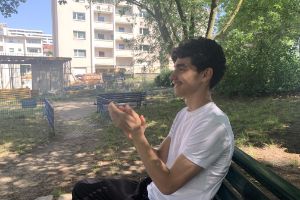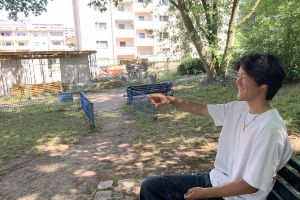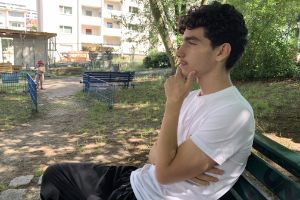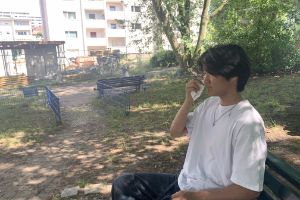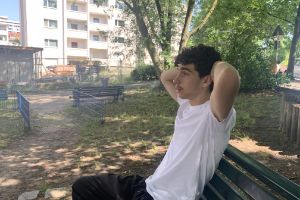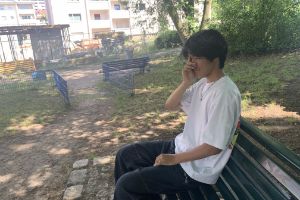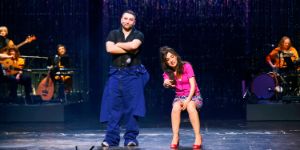
Unser Deutschlandmärchen
© Ute Langkafel MAIFOTO
Watch. Reflect. Join the Conversation.
Berlin Students attend Theatertreffen 2025
What does it sound like when longing becomes loud? When does theatre touch not just the mind, but the whole body? What does it mean to stand between two cultures – as a daughter, as a son, as a human being?
Seventeen pupils from Rheingau Gymnasium and the LiteraturInitiative Berlin (LIN) experienced the production “Unser Deutschlandmärchen” by Berlin’s Maxim Gorki Theatre at the Theatertreffen 2025 – and responded: in texts, images and videos that sometimes quietly marvel, sometimes loudly discuss, but always remain very close to their own emotions.
Two short workshops, one before the theatre visit and one afterwards, were enough to transform initial scepticism into a lot of creative energy.
Who’s Behind It?
The collaboration between Theatertreffen and the Berlin Literature Initiative (LIN) – led by Birgit Murke – has existed since 2018. Since 2021, it has been complemented by a workshop programme focusing on performance analysis for students from LIN’s partner schools in Berlin. Theatre scholar Torsten Jost, from the Cluster of Excellence “Temporal Communities” at Freie Universität Berlin, supports the students in discovering new perspectives and exploring their own ways of seeing theatre.
In 2025, for the first time, Theatertreffen offered the students a free visit to a performance. The group was invited to attend the production “Unser Deutschlandmärchen” (Our German Fairy Tale) at the Maxim Gorki Theatre in Berlin, where they also had the chance to meet the director Hakan Savaş Mican and the dramaturge Holger Kuhla. The session was moderated by theatre educator Janka Panskus.
Together, they gave the young people plenty of space to ask questions, to discuss and to create – guiding them from the very first idea to the final upload.
Scroll on, read, watch, listen – and find out how young audiences experience theatre today. Enjoy discovering!
1
Karolina
An Emotional Rollercoaster
On 12 May 2025, as part of Theatertreffen, we attended the production of “Unser Deutschlandmärchen” based on the novel by Dinçer Güçyeter at the Maxim Gorki Theatre in Berlin. This mother-and-son story about growing up as the child of guest workers in Germany’s Ruhr region was brought impressively to the stage by director Hakan Savaş Mican.
Taner Şahintürk and Sesede Terziyan gave truly outstanding performances. The selection of songs was also excellent and their delivery was deeply moving. The dynamic energy of this musical kept me engaged throughout the entire performance – I was able to immerse myself fully in this emotional rollercoaster. In particular, the Turkish and English songs powerfully underlined the plot and made the pain of the characters even more tangible.
I especially appreciated the blend of lightness and gravity, acting and singing, as well as the direct address to the audience. This was a production that truly convinced me – one I would happily see again any time.
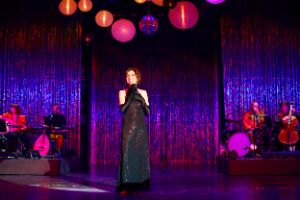
Fatma tells her family story
© Ute Langkafel MAIFOTO
2
Luise&Mieke
So Much at Once!
Art Forms in “Unser Deutschlandmärchen”
One thing is certain about the production of “Unser Deutschlandmärchen”, based on the novel by Dinçer Güçyeter: nobody will be bored! A wide range of art forms – including music, set design, dance and movement, acting and poetry – come together on stage. They create a lively, dynamic experience and make the evening both varied and truly special.
Above all, the singing of Taner Şahintürk and Sesede Terziyan brings emotions vividly to life: sorrow, love, joy, despair, anger, fear, courage, hope and forgiveness. This creates an immediate connection to the inner worlds of the characters – and to their conflicts and lived experiences.
The stage design is full of powerful and surprising moments: at the beginning, sand trickles slowly from the ceiling; later, hundreds of soup ladles crash loudly onto the stage floor. Portraits of the characters are projected and gradually, the main character’s poems fill the space – leaving visible traces across the stage.
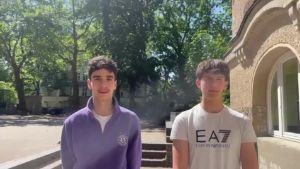
In our video – which we recorded ourselves in our schoolyard in Berlin-Steglitz – we explain what we particularly liked and were impressed by.
3
Raphaël&Subinn
The Attention Never Wavers
“Unser Deutschlandmärchen” is a production full of unexpected twists and turns. There’s laughter when the fourth wall suddenly breaks and the audience is addressed directly. Then again, there are deeply moving scenes filled with sorrow.
Beautiful, meaningful images alternate with disturbing moments. They challenge us, make us think and raise questions. Just when you think you’ve grasped the idea of the production, something completely unforeseen happens.
That’s exactly what makes this evening so special: your attention never wavers.
There is always something new to take in, as the set keeps changing constantly. You could feel and see how the actors embodied familiar themes – love, fear of loss, worry, anger and forgiveness – with great intensity, sensitivity and extraordinary harmony.
In the following photo series, we show how we, as audience members, physically responded to what was happening on stage – at times thoughtful, at times surprised, often in an immediate and instinctive way. Our bodies themselves became part of the performance.
Our Reactions to the Stage Experience
4
Eliza,Agnes&Viktoria
A Mother Sings Her Way into the Heart
Director Hakan Savaş Mican has transformed Dinçer Güçyeter’s novel into a multi-layered stage production. The transition from poetic book to an emotionally charged theatrical experience is achieved with impressive skill. The emotions of the characters become intensely tangible – and thus understandable – through the use of various art forms, including music, poetry, acting and movement.
The mother, who otherwise appears cold and strong, is revealed in a completely new light through Turkish songs such as “Sevda Olmasaydı”: vulnerable and full of feeling. Her narration of her family’s history and migration story is also especially stirring.
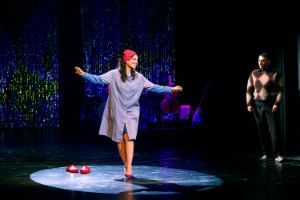.jpg)
Fatma tries on the pink pumps her son bought her with his first paycheck
© Ute Langkafel MAIFOTO
The development of Dinçer, her son, is portrayed, among other things, through a variety of musical styles – key word: Herbert Grönemeyer! In one scene, he writes his first poems in chalk on the stage floor; in another, he strikes an anvil with a hammer. Anger, longing, love for his mother and the yearning for freedom and self-expression – all of this is conveyed through at times surreal images and moments, drawing the audience deep into a moving and personal story.
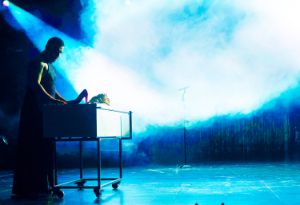.jpg)
Dinçer at his mother's coffin
© Ute Langkafel MAIFOTO
5
Miren&Ida
A Lasting Impression
We had no high expectations for the production – but we were very pleasantly surprised. Two scenes in particular left a lasting impression on us.
The first was the moment when Fatma asked the women on the bus about their husbands and their well-being. This scene moved us because it reflects the lives of these women in a direct and honest way. As we ourselves often hear about or witness shocking experiences of women in everyday life, this scene was especially emotional and meaningful for us. It also reveals the deep love Dinçer feels for his mother – a feeling that runs throughout the entire production.
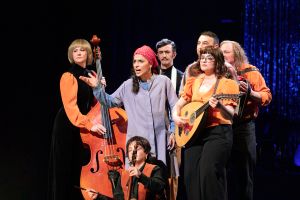
Dinçer and his mother Fatma (with red headscarf) on the bus on the way to work
© Ute Langkafel MAIFOTO
The second scene comes right at the beginning of the production. Fatma stands on stage in a state of despair – she longs for a child, but is unable to conceive. In her desperation, she turns to Mary, even though she does not belong to the Christian faith. We assume that she addresses Mary because she is a woman – someone from whom Fatma hopes to receive understanding, comfort and help. Fatma has undergone several operations, but nothing has worked. Mary is her last hope. This scene is dramatic, yet also deeply moving and beautiful – it stayed with us for a long time.
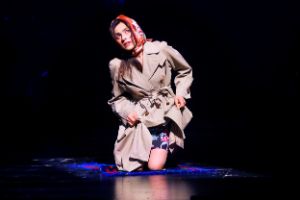
Fatma praying to Mary
© Ute Langkafel MAIFOTO
6
Valentin,Leo&Ian
Clearly Ambiguous
In the production “Unser Deutschlandmärchen”, confusion is deliberately employed to highlight the identity crises of the characters. Dinçer and his mother Fatma move within the tension between two cultures, searching for their place in society.
The collage of flashbacks and surreal elements reflects their inner turmoil. Particularly the red shoes and the repeated appearance of the figure “Heidi”, frequently mentioned by the mother, initially create a sense of confusion – heightened by the interplay of acting and projections on stage.
Only in later scenes does the significance of these symbols become clear. As a result, their emotional depth unfolds without the production becoming obscure. It is precisely this play with ambiguity that makes the evening so multi-layered and especially powerful.
Our classmate Leo Brabandt created his own installation in response to the production, setting it up in his kitchen and capturing it in photographs. The image shows falling cutlery – a visual that recalls the moment in the production when objects suddenly crash down from the stage ceiling. What first seems confusing later reveals strong symbolic meaning. Leo’s image demonstrates how this effect works: first chaos, then significance.
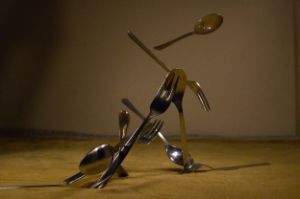
Falling Chaos
© Leo Brabandt
7
Nuri,Emmi&Anes
Unexpectedly Captivating
Our initial expectations:
To be honest, we thought it would be boring – a monologue with dull background music and a story we wouldn’t really care about. We assumed it would be the same as always.
But what it actually turned out to be:
The production was surprising and original. The music, the structure, the way the story was told – everything was unconventional and immediately grabbed our attention. And it kept us engaged for the entire duration of the performance, which really isn’t easy to achieve with us. It had everything: suspense, emotion, love, humour. We genuinely enjoyed it and it was an honour to be invited to such an experience and to be a part of it.

Standing Ovation
© AI-generated with Piclume
